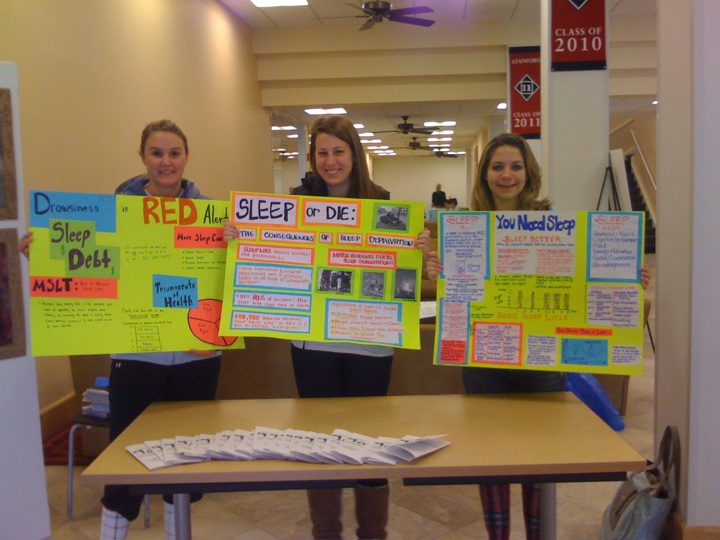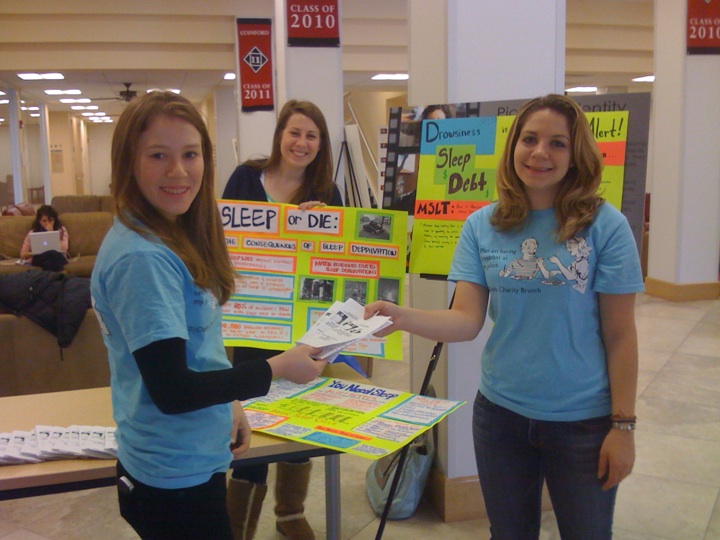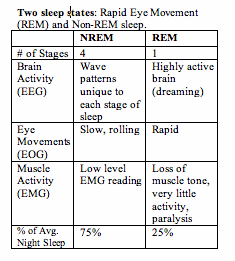Stanford Sleep Awareness Day
On Tuesday, February 17, 2009 Stanford students could stop by White Plaza between noon and one to learn about how sleep affects them in their daily lives and the importance of getting proper sleep. Here's a look at what the three ladies had set up to teach their fellow sleepy Stanford students about the importance of sufficient snoozing:




Ahhhhh sleep. Beautiful pictures. And now for their information:

Learn to Love Sleep
Proper Sleep improves:
• Alertness & Focus
• Cognitive Performance & Memory
• Mood
• Energy & Motivation
• Control & Coordination
• Pain Management
At the Moment of Sleep, the door of perception slams shut. When asleep, we are in a state of perceptual disengagement with the env’t, unable to make meaningful responses to stimuli. Don’t worry sleeping beauties: sleep is also reversible.
At sleep onset, we observe:
• Cessation of alpha rhythms: a brain wave pattern characteristic of our waking state
• Sleep-related retrograde amnesia: can’t remember last thought before moment of sleep
• Hypnagogic imagery: vague images or disconnected thoughts
• Hypnic Jerks (AKA Sleep Starts): falling sensation, accompanied by muscle jerk(s) w/in the first 5 min.
The Dual Process Model of Sleep
Sleep Homeostasis: Process whereby sleep drive goes up as sleep debt increases
Clock Dependent Alerting: Biological clock alerts the body @ certain hours.
EG: College kids are often more alert from 8-10 PM than when they wake up in the AM. Sleep need is great; CDA is greater.

Adults typically need just over 8 hrs of sleep/night. College kids may need more.
Helpful Sleep Tips (From Dr. Dement):
• Avoid caffeine 6 hrs before bed.
• Avoid alcohol
• If stressed, set aside a “worry time” @ least 1-2 hours before bed
• Establish a relaxing pre-sleep ritual
• If you can’t sleep after 10-15 mn, leave the room and do something boring for 20-30 mn. Then try again.
Sleep Debt 101: Definitions
Sleep Debt: “the result of recurrent sleep deprivation which occurs over time when an individual does not experience a sufficient amount of the restorative daily sleep that is required to maintain a sense of feeling rested and refreshed. Lost sleep causes: decreased quality of life, onset of related health problems, increased risk of injury and/or accident.
Sleep tendency: “specific propensity to fall asleep, the strength of which is determined homeostatically based on the level of prior Sleep Debt accumulated since the last sleep interval coupled with the amount of pre-existing Sleep Debt. Sleep tendency builds in all waking hours.”
The Multiple Sleep Latency Test (MSLT) measures the effects of sleep deprivation on sleep tendency. The Stanford Sleep Study conducted by Dr. Dement at Stanford University, proved that the amount of sleep necessary for people to feel completely alert during the day does not decrease with age. It may even be larger. It is just as important for adults to get the same amount of sleep as adolescents, although often adults get a significantly lower amount.
Sleep in College:
College students acquire particularly large amounts of sleep debt by staying up late for assignments & parties, or pulling ‘all-nighters’. Such accumulation of Sleep Debt can have serious implications, such as sleep related accidents.
Decreasing Sleep Debt and Increasing Alertness:
People who feel very tired and sleepy throughout the day can increase their alertness by reducing their sleep debt and spending an extra couple of hours each day sleeping, whether it is by increasing the amount of nighttime sleep or taking naps. Which ever the solution, decreasing your sleep debt is very important and will have a major impact on your life.
SLEEP OR DIE:
Consequences of Sleep Deprivation
There is conclusive scientific evidence that sleep loss impairs alertness and performance and that the impairment increases progressively as a function of the size of the sleep debt.
Sleep crisis is a sudden or unexpected summons to stay up all night for some critical task or emergency which adds to sleep debt
80% of car accidents that start with sleep end in death.
Approximately 100,000 vehicular accidents a year in the United States are officially attributed to fatigue and sleepiness each year.
Specialists draw analogies between sleep deprivation and the specific levels of blood
alcohol that have been deemed illegal for driving in every state in the U.S.
Here are some real world examples of potential consequences of sleep deprivation:
The National Transportation Safety Board has concluded that sleep deprivation and related impairment was a primary cause in at least ten catastrophic railroad accidents between 1987 and 1998.
Sleep deprivation was responsible for America’s largest oil spill when on March 24, 1989 the oil tanker Exxon Valdez ran aground in the waters of the Prince William Sound.
The Human Factors Subcommittee attributed the decision to launch the space shuttle Challenger in the absence of adequate data to the severe sleep deprivation of NASA managers.
Early morning human errors led to Chernobyl, the worst accidental nuclear catastrophe in world history.










